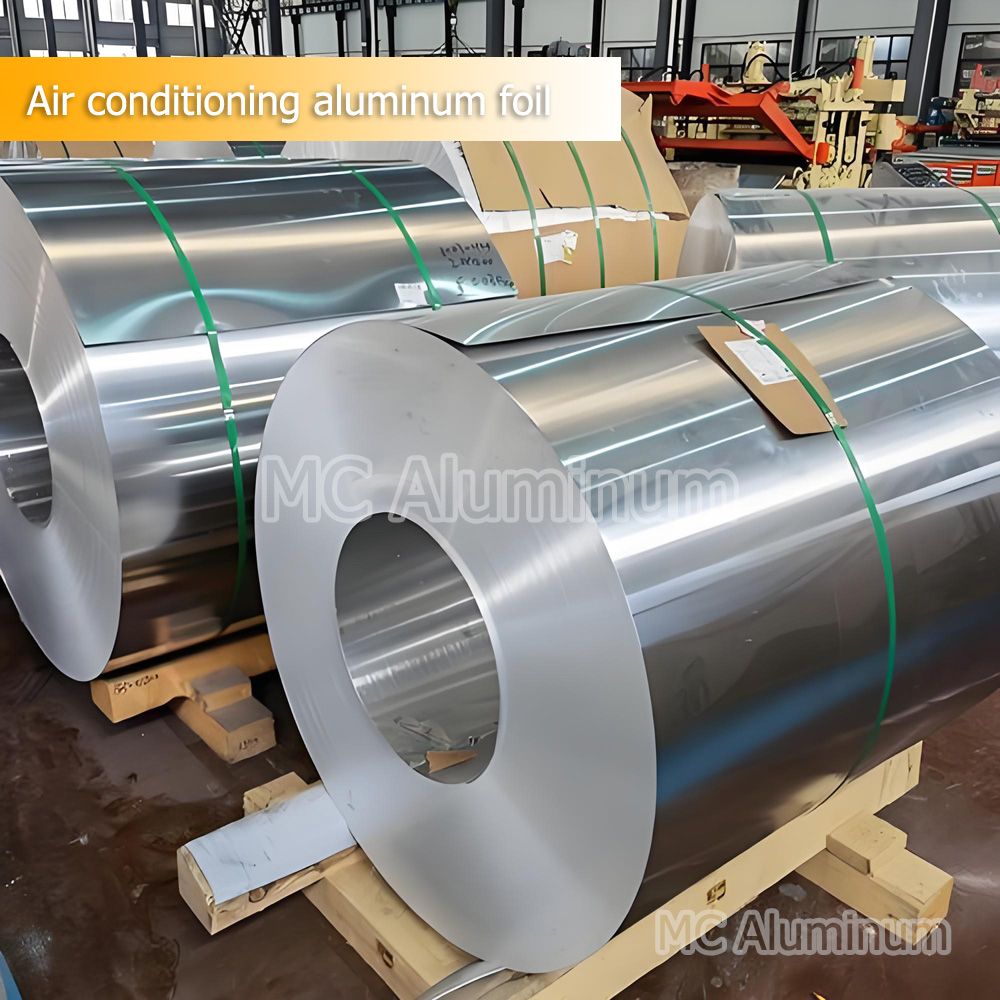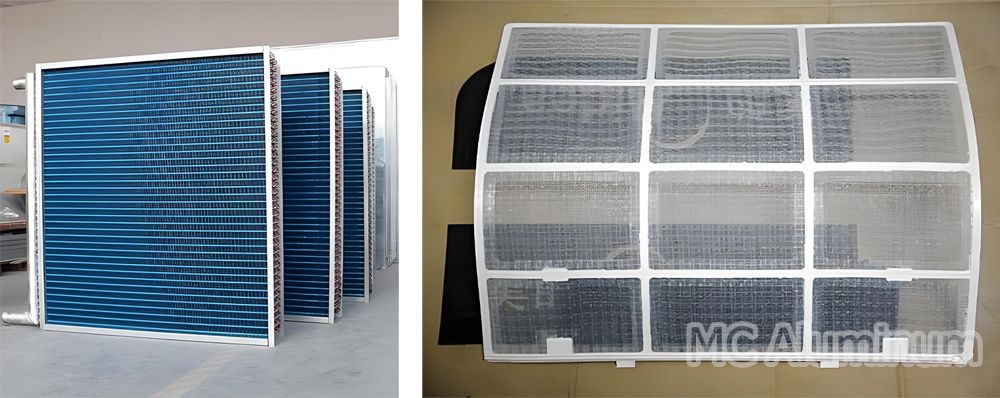In modern air conditioning systems, aluminum foil plays a critical role as one of the core heat exchange materials, widely used in the manufacturing of evaporator and condenser fins. MC Aluminum produces air conditioning aluminum foil using aluminum alloys such as 8011, 1100, 3102, and 3003, typically in H22 and H24 (semi-hard) tempers. The production thickness ranges from 0.08mm to 0.2mm, and the surface is treated for use in heat exchanger fins of air conditioning units.
The main types of air conditioning foil include hydrophilic aluminum foil, bare aluminum foil, hydrophobic aluminum foil, and coated aluminum foil.
Product Information:
| Alloy/Temper | 8011-H22, 1100-H24, 3102-H24, etc. |
| Thickness | 0.08mm – 0.20mm |
| Width | 200mm – 1300mm (customizable) |
| Length | 100mm – 6000mm |
| Surface Treatment | Hydrophilic coating, anti-corrosion coating, embossed finish, etc. |
| Elongation | ≥12% |
| Coating Adhesion | ≥ Grade 1 (National/Industry Standard) |
| Pinholes | ≤20/m² (high-precision standard) |
| Sample | Available |
| Packaging | Standard wooden crate packaging, customizable upon request |
| MOQ | 1–3 tons |

Functions of Aluminum Foil in Air Conditioners
1.Excellent Thermal Conductivity:
With a thermal conductivity of up to 237W/m·K, aluminum foil accelerates heat transfer and improves air conditioning efficiency.
2.Lightweight:
Aluminum has a low density (about 2.7g/cm³), reducing the overall unit weight and enhancing energy efficiency.
3.Great Formability:
Thin and flexible, aluminum foil is easy to process for fin stamping, bending, and shaping, making it suitable for mass production.
4.Superior Corrosion Resistance:
With surface coatings, aluminum foil resists moisture, chemicals, and salt spray, extending air conditioner lifespan.
5.Eco-Friendly and Recyclable:
Aluminum foil is 100% recyclable, supporting green manufacturing and sustainability goals.
6.Cost Efficiency:
Compared to high thermal conductivity materials like copper, aluminum foil is more cost-effective for large-scale production.
Applications of Air Conditioning Aluminum Foil
Aluminum foil serves multiple technical roles in air conditioning systems, primarily enhancing heat exchange efficiency, structural support, and system insulation.
Evaporator Fins
Function:
Used as fin material in evaporators, aluminum foil rapidly absorbs heat from the air due to its high thermal conductivity (up to 55%), enabling refrigerant evaporation and effective cooling.
Advantages:
Smooth surface resists dust accumulation, ensuring long-term performance. Hydrophilic coating guides condensation water along the fin surface, preventing water bridges that obstruct airflow—improving heat exchange by 10–15% and saving energy at the same cooling output.
Condenser Fins
Function:
In condensers, aluminum foil fins help dissipate the heat released by the refrigerant into the surrounding air, completing the thermal cycle.
Advantages:
Anti-corrosion coatings (e.g., acrylic resin) protect against moisture-related degradation. Hydrophobic foil increases the water contact angle (>75°), allowing water to slide off quickly, minimizing corrosion risk.
Air Filtration and Purification
Aluminum Foil Mesh Applications:
Made from 8011 alloy foil, these specialized mesh structures use a dual-layer design—corrugated outer layer for rigidity and multilayered foil mesh inside—to filter particles larger than 5μm from the air, with filtration efficiency over 85%.
Specifications:
Mesh sizes range from 1×2mm to 6×12mm, suitable for air inlets, outlets, and large duct filters in HVAC systems.

